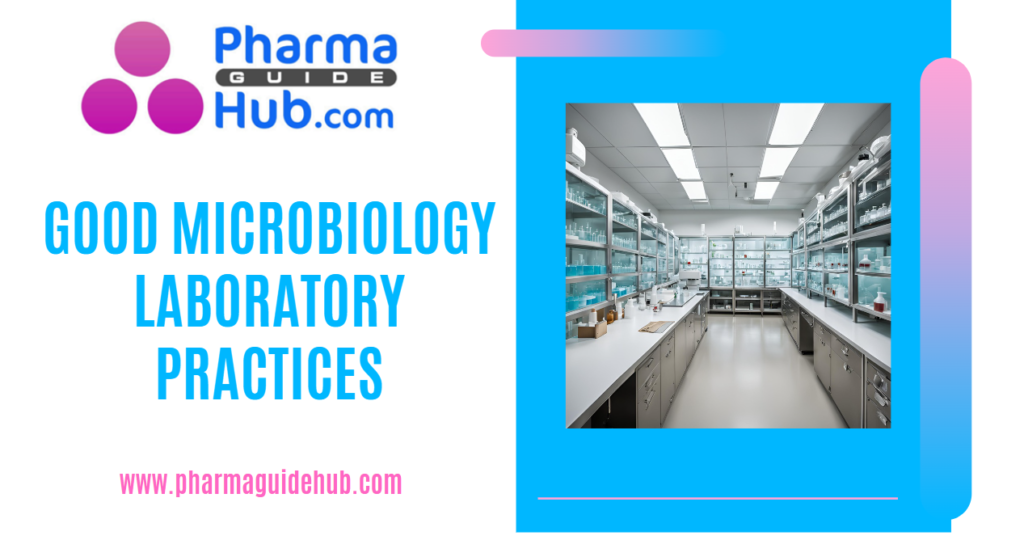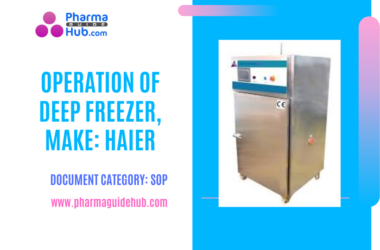
- OBJECTIVE:
To lay down a procedure for good microbiology laboratory practices.
- SCOPE:
This SOP is applicable for good microbiology laboratory practices at {Company Name} {Location}.
- RESPONSIBILITY:
- Microbiologist- to follow the procedure as per SOP.
- In charge-Microbiology/ Head-Quality Control: for review and approval of SOP.
- ACCOUNTABILITY:
QA Head shall be Accountable for implementation of SOP.
- PROCEDURE:
DEFINITIONS The definitions listed here apply in the context of this SOP and may or may not be applicable in all other usage.
Reference material– Material sufficiently homogeneous and stable with respect to one or more specified properties, which have been established to be fit for its intended use in a measurement process.
Verification– The application of methods, procedures, tests and other evaluations, in addition to monitoring to determine compliance with GxP principles.
Man-Material flow– The flow of incoming and outgoing material and personnel in the laboratory through a specified and documented pathway chosen to reduce or minimize microbial contamination of the product/closure/container system.
Click the link for download word file copy of this document: https://pharmaguidehub.com/product/good-microbiology-laboratory-practices/
Principle:
Good laboratory practices in a Microbiology laboratory consist of activities that depend on aseptic technique, control of media, control of test strains, operation and control of equipment, careful recording, data evaluation and adequate training of the laboratory staff.
Due to inherent risk of variability in microbiology data, reliability and reproducibility are dependent on the use of validated methods and adherence to good laboratory practices.
Good Laboratory practices (GLP):
Laboratory layouts and operation:
Microbiology Laboratory area should be separated and divided in various sections such as sample storage, media preparation, testing, washing area and media destruction area to minimize risks of cross contamination, false results.
Appropriate area classification shall be maintained based on the criticality of the operation being carried out in the area.
Approved laboratory layout should be available in the laboratory showing room identification with respect to their operation, classification and Man – Material flow.
Adequate power supply and light shall be available in the microbiology laboratories.
Access to the Microbiological laboratory should be restricted to authorized personnel.
Water for laboratory use, HVAC system, temperature, pressure differential, relative humidity (% RH) should be monitored at defined frequencies for predefined parameters.
Sterility testing facility:
Sterility testing should be performed under aseptic conditions equivalent to air quality standards required for the aseptic manufacture of pharmaceutical products.
The sterility testing should be carried out within ISO 5 Laminar airflow protected zone which should be located within a clean room with ISO 6 background.
Personnel working in sterility testing area should be qualified before working in the area.
Environment monitoring in the laboratory:
Environmental monitoring programme for viable count should be in place which covers, monitoring of air by air sampling and settling plate, surfaces and personnel as applicable.
Locations for sampling, exposure duration and frequency of all types of microbiological environmental monitoring should be specified in written procedures.
Laminar airflow shall be monitored during the testing to get real time data.
Alert and action limits should be defined and trending of environmental monitoring results shall be done at predefined frequencies.
Cleaning, disinfection and hygiene:
A documented cleaning and disinfection programme should be available in the Microbiology laboratory.
Disinfectants should be validated for their use dilutions/concentrations and efficacy.
Disinfectant preparation and usage shall be performed as per the standard operating procedure.
Hand-washing facilities and procedure should be available in the laboratory.
Procedure for handling spillage or mishaps with live cultures and media should be available in the laboratory.
Click the link for download word file copy of this document: https://pharmaguidehub.com/product/good-microbiology-laboratory-practices/
Laboratory Personnel:
Personnel engaged in each phase of activity should have relevant education, experience and training for the competent performance of tests and operations.
Laboratory staff should have basic training on microbiological techniques and relevant practical experience before performing the work.
Job descriptions for all laboratory personnel including their qualifications, training, experience and current job responsibility should be maintained.
Job responsibility shall be assigned based on their level of skill and experience.
Laboratory Equipment/Instruments:
All laboratory equipment/instrument or devices should be uniquely identified and their approved list should be available in the Microbiology laboratory.
All instrument/equipments should be calibrated/validated before use.
Laboratory should have a documented programme for qualification, calibration, performance verification, maintenance of equipments/instruments.
Equipment used in the microbiology laboratory should not be used outside the microbiology area, unless there are specific precautions in place to prevent cross contamination.
Procedure for operation, calibration, cleaning and handling the instrument/ equipment breakdown shall be available in the microbiology laboratory.
Laboratory Reagents and culture media:
Laboratory should verify the suitability of each batch of reagents, initially and during its shelf-life.
Water of suitable microbiological quality free from bactericidal, inhibitory or interfering substances, should be used for preparation.
Media shall be prepared in-house or purchased either partially or fully prepared.
Vendors of purchased media should be approved and qualified.
Growth promotion test should be done on all media on every batch and each sterilized media lot.
Media containing anti-metabolites or inhibitors should be prepared using dedicated glassware, as carry-over of these agents into other media could inhibit the growth and detection of microorganisms present in the sample under test.
If dedicated glassware is not used, washing procedures for glassware should be validated.
Media should be prepared in accordance with manufacturer’s instructions, taking into careful account specifications such as time and temperature for sterilization.
The shelf-life of prepared media under defined storage conditions shall be determined and verified.
Laboratory should ensure that all consumable, sterilized items, reagents, media, diluents and other suspending fluids are adequately labelled for their identity, concentration, storage conditions, and preparation date, validated expiry date and/or recommended storage periods.
An Inventory management system shall be followed by the laboratory.
Reference materials and reference cultures:
Certified reference materials shall be used in a microbiological laboratory to qualify, verify and calibrate equipment.
These reference materials should be traceable to appropriate international standards and pharmacopeial reference substances.
Reference cultures used should be procured directly from a recognized national or international collection. Reference cultures shall be subcultured once to provide reference stocks.
Purity and biochemical checks for reference cultures should be made in parallel as appropriate and shall be stored either deep-frozen or lyophilized.
Microbial culture used in routine should not be more than five generations (or passages) from the original reference strain.
Validation of test methods:
Test methods used in the laboratory should be evaluated for their suitability in recovering bacteria, yeast and mould in the presence of the product.
Other methods which are not based on compendia or other recognized references should be validated before use.
Establishment of standard operating procedure:
All operations in Microbiology laboratory should be identified, evaluated and standardized in the form of standard operating procedure.
Standard operating procedures should be displayed or kept at the working area as appropriate.
Microbiological Sampling:
Sampling should be performed by trained personnel under aseptic conditions as applicable.
Transport and storage of samples should be under conditions that maintain the integrity of the sample (e.g. chilled or frozen where appropriate).
Testing of samples should be performed as soon as possible after sampling.
Samples where a growth in the microbial population during transport and storage is possible it should be demonstrated that the storage conditions, time and temperature, will not affect the accuracy of the testing result.
Sample management:
Procedure for sample receipt, storage, sample allotment, testing, reconciliation and disposition should be available in the Microbiology laboratory.
The samples shall be stored in a dedicated area with appropriate control.
In case of insufficient sample or sample in poor condition due to physical deterioration, incorrect temperature, torn packaging or deficient labelling, the laboratory should not accept the sample.
Samples should be stored under suitable conditions to minimize changes to any microbial population present.
Disposal and safety procedures:
Procedures for disposal of contaminated materials and waste should be established and followed to minimize the contamination of test environment or materials as per national/international environmental or health and safety regulations.
A procedure for disposal and handling of toxic and hazardous material should be available in the laboratory.
Emergency and accident handling procedures should be available in the Laboratory.
Laboratory staff should be trained on the Emergency and accident handling procedures.
Compliance of laboratory procedures, practices:
Analysis shall be performed according to standard and validated test procedures.
Alternative testing procedures may be used if they are appropriately validated and equivalence to official methods has been demonstrated.
Laboratory staff is responsible to adhere and follow defined procedures and practices in a correct and disciplined manner.
The documentary evidence shall be generated during performing the operation with real time attribute.
Online compliance to the defined procedures, practices and documentation shall be verified on regular basis by the laboratory in charge or designee.
The laboratory should have a system of internal quality review to evaluate and ensure the correctness of day to day results and their conformity with defined criteria.
An investigation procedure should be available to handle non conformance of the results.
Good Documentation practices (GDP):
Online data recording during analysis, monitoring and calibration/validation studies should be done.
Changes in the data should be crossed off with a single line and initialed.
Original data should not be erased or covered over.
Weigh prints, Charts or graphs should be secured with clear tape and should not be obstructing any data on the page.
The chart or graph should be signed by the person adding the document, with the signature overlapping the chart and the notebook page.
Laboratory records should be archived and protected against catastrophic loss as per SOP.
Click the link for download word file copy of this document: https://pharmaguidehub.com/product/good-microbiology-laboratory-practices/
REFERENCES:
Not Applicable
ANNEXURES:
Not Applicable
ENCLOSURES: SOP Training Record.
DISTRIBUTION:
Master Copy : Quality Assurance Department
Controlled Copy No. 01 : Head Quality Assurance
Controlled Copy No. 02 : Head QC (Micro)
ABBREVIATIONS:
| QC | : | Quality control |
| No. | : | Number |
| SOP | : | Standard Operating Procedure |
REVISION HISTORY:
CHANGE HISTORY LOG
| Revision No. | Details of Changes | Reason for Change | Effective Date |
| 00 | New SOP | Not Applicable | To Be Written Manual |
Click the link for download word file copy of this document: https://pharmaguidehub.com/product/good-microbiology-laboratory-practices/

